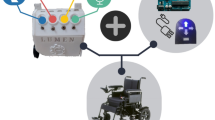Abstract
This paper presents an interface to control an electric wheelchair by using the movements of the head, the voice and a mobile device. The system aims to cover the need of independence of severe disabled people that cannot use a common wheelchair joystick. The structure of the system as well as the preliminary results obtained are presented in this paper.
Access this chapter
Tax calculation will be finalised at checkout
Purchases are for personal use only
Preview
Unable to display preview. Download preview PDF.
Similar content being viewed by others
References
Infrared Non-Contact Head Sensor, for Control of Wheelchair Movements, http://citeseerx.ist.psu.edu/viewdoc/download?doi=10.1.1.86.8316&rep=rep1&type=pdf
SIAMO Wheelchair project, http://www.geintra-uah.org/archivos/1999-HMIs-Wheelcair-UAH.pdf
Bradski, G., Kaehler, A.: Learning OpenCV: Computer Vision with the OpenCV Library (2008)
Optical Flow guide, http://robots.stanford.edu/cs223b05/notes/CS%20223-B%20T1%20stavens_opencv_optical_flow.pdf
Viola, Jones: Rapid object detection using boosted cascade of simple features. In: Computer Vision and Pattern Recognition (2001)
Microsoft site for SAPI, http://www.microsoft.com/speech/default.aspx
Author information
Authors and Affiliations
Editor information
Editors and Affiliations
Rights and permissions
Copyright information
© 2011 Springer-Verlag Berlin Heidelberg
About this paper
Cite this paper
Berjón, R., Mateos, M., Barriuso, A., Muriel, I., Villarrubia, G. (2011). Head Tracking System for Wheelchair Movement Control. In: Pérez, J.B., et al. Highlights in Practical Applications of Agents and Multiagent Systems. Advances in Intelligent and Soft Computing, vol 89. Springer, Berlin, Heidelberg. https://doi.org/10.1007/978-3-642-19917-2_37
Download citation
DOI: https://doi.org/10.1007/978-3-642-19917-2_37
Publisher Name: Springer, Berlin, Heidelberg
Print ISBN: 978-3-642-19916-5
Online ISBN: 978-3-642-19917-2
eBook Packages: EngineeringEngineering (R0)




